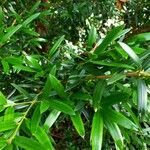A medium sized tree. It grows to 5-15 m high. It can be 40 m tall. It spreads 3.5-8 m wide. The bark is grey to brown and fibrous. The branches stick out or curve upwards. The young growth is yellowish green or pink. The small branches have ribs. The leaves are 6-18 cm long by 0.5-1.4 cm wide. They are deep green on top and paler underneath. The male cones are about 3 cm long. They are in clusters in the axils of leaves. They have very short stalks. The female cones are single and greenish on a large fleshy blue black stem. These plum like fruit are edible.


